The Centers for Disease Control and Prevention's (CDC) “Preventing Adverse Childhood Experiences: Data to Action (PACE-D2A)” has been underway for about a year and a half (announced September 4, 2020), adding two awardees to the original four to participate in the three-year, $6-million project. PACE-D2A is a major addition to CDC’s already robust portfolio addressing the prevention of ACEs and building resilience in individuals, families, and communities.
The initial awards were made to the Departments of Public Health in Georgia and Massachusetts, the Office of Early Childhood in Connecticut, and the Michigan Public Health Institute (MPHI). MPHI is a non-profit research institute established by the Michigan legislature to build the capacity of the state to quickly address urgent issues, the COVID crisis being the latest. After the initial awards of $500,000 annually for three years were announced, two other awardees were added—the Center for Health Care Strategies and the Minnesota Department of Health.
This article will focus on the work being done in CDC’s home state of Georgia by the state’s Department of Public Health (DPH). Articles on Michigan and Massachusetts have been posted here in PACEs Connection when those states were in the first year of the program. Another article on the Minnesota project appeared here on March 1. On the CDC PACE: D2A page, there are summaries for Connecticut, Georgia, Massachusetts, and the Michigan Public Health Institute. (Summaries are coming soon for Minnesota and the Center for Healthcare Strategies). The summaries cover surveillance activities, prevention strategies and approaches, and early successes during the first two years of the program.
PACE: D2A Award—Georgia Department of Public Health
In the early days of the PACE-D2A grant, Chinyere Nwamuo, the project’s first principal investigator, said several “puzzle pieces came together perfectly with this award.” She said Georgia’s participation in CDC’s Essentials for Childhood program is foundational to the work of the award. For seven or more years, Georgia participated in the Essentials program as an unfunded state, receiving technical assistance and support for the work to implement the program’s framework with goals to “create safe, stable, and nurturing relationships and environments for children.” Nwamuo has left the Georgia Department of Public Health to pursue a PhD at Harvard University.
The new PACE team includes Grace Morrow, MPH, PACE: D2A program manager and principal investigator, Injury Prevention Program, Georgia Department of Public Health (DPH); and Elizabeth Otwell, PACE: D2A data coordinator and evaluator, Injury Prevention Program, DPH. In a recent interview, Morrow stressed the foundational role of Georgia Essentials for Childhood has played in the PACE: D2A project—building on existing state agency partnerships—and how a focus on community involvement is embedded in the project.
The structure for the Georgia Essentials for Childhood work facilitated both the application for PACE: D2A funding and the work going forward. The Georgia Essentials’ steering committee and work groups include diverse membership—from individuals from state organizations and community-oriented groups. As a self-supported state, Georgia Essentials is funded through the Community-Based Child Abuse Prevention (CBCAP) federal grant fund provided by the Georgia Division of Family and Children Services’ Prevention and Community Support Section (PCS). Prevent Child Abuse Georgia, housed at Georgia State University, oversees and coordinates the Georgia Essentials initiative, with the assistance of a contracted consultant. The three backbone agencies of the initiative include PCS, Prevent Child Abuse Georgia, and the Georgia Department of Public Health’s Injury Prevention Program. There are five working groups in Essentials: Communication and Outreach, Data, Policy, Programs and Practices, and Child Abuse and Neglect Prevention Plan (CANPP). The Georgia PACES: D2A team participates in four of the Essentials’ work groups and the steering committee.
Lisa Dawson, director of the Injury Prevention Program within the Division of Health Protection at the Georgia DPH, described how the early work of Essentials for Childhood catalogued how it was working on “safe, stable, nurturing relationships and environments” and sought to find where other work was being done in the state, including government agencies and private organizations, to coordinate efforts and identify any existing gaps. She said the Essentials’ team was “very intentional about putting the safe, stable, nurturing relationships and environments language into all of our plans, all of our reports, and all of our recommendations to be sure that we were using consistent language and also referencing each other's reports and plans.”
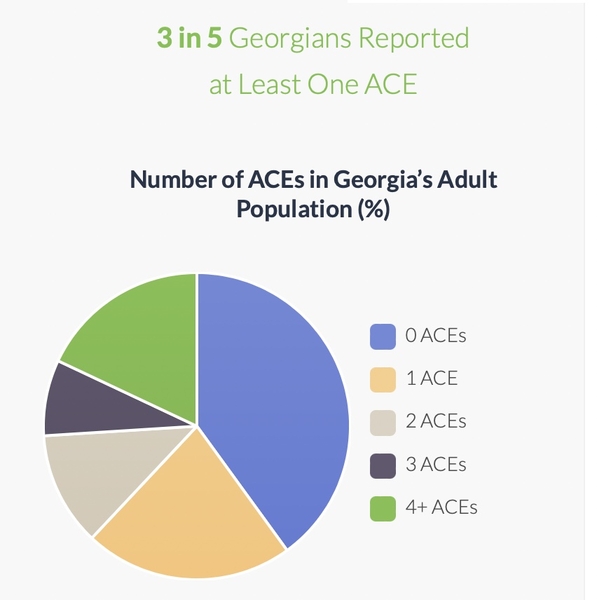 Data and Surveillance in Georgia
Data and Surveillance in Georgia
Another key partner in the program addressing data and surveillance is the Injury Prevention Research Center Emory (IPRCE) headed by Jonathan Rupp who is also director for research and associate professor, Emory University Department of Emergency Medicine. Rupp says that existing data activities added to the strength of the proposal, along with collaboration and structures forged by Essentials. Georgia included the ACEs module in the Behavioral Risk Factor Surveillance Survey (BRFSS) in 2016 and 2018 and found that 3 of 5 Georgians have experienced at least one ACE. This statewide data, along with the fact that Georgia ranks 38th in measures of child well-being (2021 Kids Count Data Book, Annie E. Casey Foundation), has brought urgency to efforts to prevent and mitigate the effects of ACEs in the state.
PACE: D2A is utilizing data—the Youth Risk Behavior Surveillance System (YRBSS), the Georgia Student Health Survey, and the BRFSS, and others—collected by a variety of agencies including the DPH’s epidemiology section (the DPH has a data warehouse called “Oasis”). Morrow says the department will be analyzing the newly included ACEs module in the BRFSS in partnership with IPRCE and the DPH’s Epidemiology Section. Rupp says that some of the data from the Governor’s Office of Student Achievement related to graduation and disciplinary rates are indicators of ACEs and are valuable data sources. He says community level data provides a local context that is needed to motivate prevention activities.
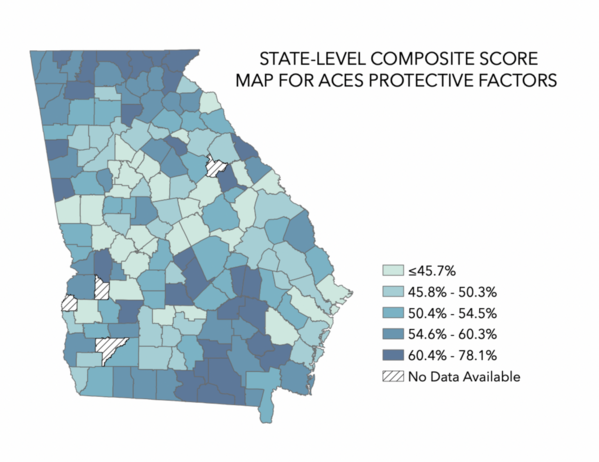
Data from the PACE: D24 project, including data at the school district and census tract level, are being made available as factsheets and a mapping tool that allows users to view data relevant to ACEs prevention in Georgia. Factsheets and the mapping tool can be accessed from ACEs in Georgia section on the IPRCE website. Information from the Georgia Student Health Survey (GSHS) Analysis includes county-level data for both the ACE Protective Factor Composite Score and the ACE Risk Force Composite Score. Data will be added to the tool and new factsheets will be generated throughout the PACE: D2A project.
Georgia Essentials for Childhood spurred the development of a new state plan
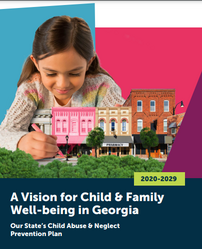 One of the key foundational activities that the Georgia PACE: D2A program builds upon is the work of the state’s Essentials for Childhood coalition that led the creation of a state plan entitled “A Vision for Child & Family Well-Being in Georgia.” The previous plan was issued nearly 30 years ago. The state plan web page describes the process used to update the plan that included about 30 meetings around the state, bringing together state officials, providers, caregivers, educators, and others. In addition, two surveys soliciting input from providers and parents/caregivers were distributed and considered in the plan’s update. The Essentials steering committee and the CANPP working group are responsible for the plan’s implementation, monitoring of progress, and regular updates.
One of the key foundational activities that the Georgia PACE: D2A program builds upon is the work of the state’s Essentials for Childhood coalition that led the creation of a state plan entitled “A Vision for Child & Family Well-Being in Georgia.” The previous plan was issued nearly 30 years ago. The state plan web page describes the process used to update the plan that included about 30 meetings around the state, bringing together state officials, providers, caregivers, educators, and others. In addition, two surveys soliciting input from providers and parents/caregivers were distributed and considered in the plan’s update. The Essentials steering committee and the CANPP working group are responsible for the plan’s implementation, monitoring of progress, and regular updates.
The plan establishes six objectives intended to help child-and family-serving organizations, community members, families, and businesses create nurturing environments for healthy families. The objectives include increasing family economic stability, resilience, mental health, and physical health as well as access to quality, affordable early childhood care and education and community knowledge and awareness of the societal factors that contribute to child abuse and neglect and the capacity to prevent it.
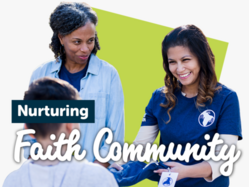 The plan makes the case that child abuse and neglect are the “public’s health problem,” caused by multiple factors at the individual, family, community, and societal levels. The state has established ways for the public at large to be involved in addressing the problem and describes them on the Belonging for Hope website. Suggested actions to be taken are described for parents, friends, neighbors, coworkers, mentors, educators, faith or business leaders, and others.
The plan makes the case that child abuse and neglect are the “public’s health problem,” caused by multiple factors at the individual, family, community, and societal levels. The state has established ways for the public at large to be involved in addressing the problem and describes them on the Belonging for Hope website. Suggested actions to be taken are described for parents, friends, neighbors, coworkers, mentors, educators, faith or business leaders, and others.
In addition, 14 regional plans were developed in 2021 that prioritize strategies on child well-being data, community needs and existing efforts. This work was done in the 14 Family and Children Services (DFCS) regions in the state where community involvement was encouraged. Georgia Essentials is both leading the implementation of the CANPP and supporting the 14 regions with their plan implementation, according to Morrow. The 14 regions chose 19 strategies overall from the CANPP to implement, but six of them were chosen by multiple regions, reports Morrow. The Essentials’ CANPP working group will be launching communities of practice to provide technical assistance and support around the six strategies chosen by multiple regions in early 2022. Click here for additional information on CANPP, including the 14 CANPP regional plans.
Deborah Chosewood, deputy section director – Prevention and Community Support, Georgia Division of Family & Children Services and a leader in the Essentials program, believes that building on the Essentials work will ensure that the work will continue after PACE: D2A funding ends. Because they were able to create the Essentials program without CDC funding, they are confident they can sustain the work of the PACE: D2A project, according to Chosewood.
In addition to addressing surveillance and data, the second task for the awardees is implementing evidence-based strategies. The grant announcement said: “Recipients will focus on the implementation of at least two designated strategies derived from CDC’s Division of Violence Prevention’s (DVP) resource, Preventing Adverse Childhood Experiences (ACEs): Leveraging the Best Available Evidence. In these endeavors, recipients will be expected to leverage multi-sector partnerships and resources to improve ACEs surveillance infrastructures and to coordinate and implement ACEs prevention strategies. As a result, recipients will better understand the burden of ACEs in their communities and engage in strategies that will prevent ACES from occurring, in order to help to promote safe, stable, nurturing relationships and environments where children live, learn and play.” The “Preventing ACEs” document was released in 2019 by the Division of Violence Prevention, National Center for Injury Prevention and Control.
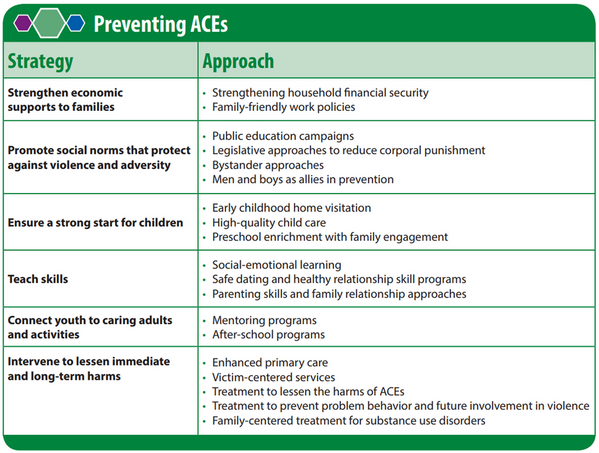
According to Morrow, PACE-2A is helping to identify gaps in services across the state for evidence-based programming, including early childhood home visitation. Early childhood visitation is part of the department’s efforts to implement the CDC’s “Ensure a strong start for children” strategy. The other CDC strategy being implementing through PACE-2A is "Promote social norms that protect against violence and adversity." For that strategy, PACE: D2A is working with DFCS to promote the Belonging for Hope campaign and the 1-800-Children Helpline.
Conclusion
During a December 15, 2021 Campaign for Trauma-Informed Policy and Practice (CTIPP) webinar, Phyllis Ottley, PhD, associate chief of program in CDC’s Division of Violence Prevention, National Center for Injury Prevention and Control, said the goal of PACE: D2A is to address and support statewide needs to measure and track and prevent ACEs because data is needed to identify what the problem is and where to intervene. She said that awardees are expected to first assess their current capacity to be able to monitor ACEs outcomes and indicators and then to determine how those strategies are actually working in the field. The outcome evaluation process should yield useful guidance to other states doing similar work.
The PACE: D2A awards have the potential to further energize an already blossoming movement of statewide community-based initiatives to address ACEs. (See the MARC survey report on ACEs, trauma, and resilience networks across the country). Congress appropriated $4 million in FY ’20 and increased it to $5 million in FY ’21 to fund PACE: D2A and “to inform how ACEs increase certain risk factors, such as substance abuse, suicide, mental health conditions and chronic illnesses,” Ottley said. The omnibus spending bill for FY '22, signed by President Biden on March 15, includes $7 million for CDC to continue its work on adverse childhood experiences.
Lessons from the four states—Georgia, Massachusetts, Connecticut, Minnesota—and the two non-profits in Michigan and New Jersey—should provide practical guidance to others on how knowledge of ACEs can transform society’s intractable problems into solutions.


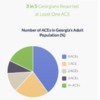



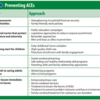
Comments (1)